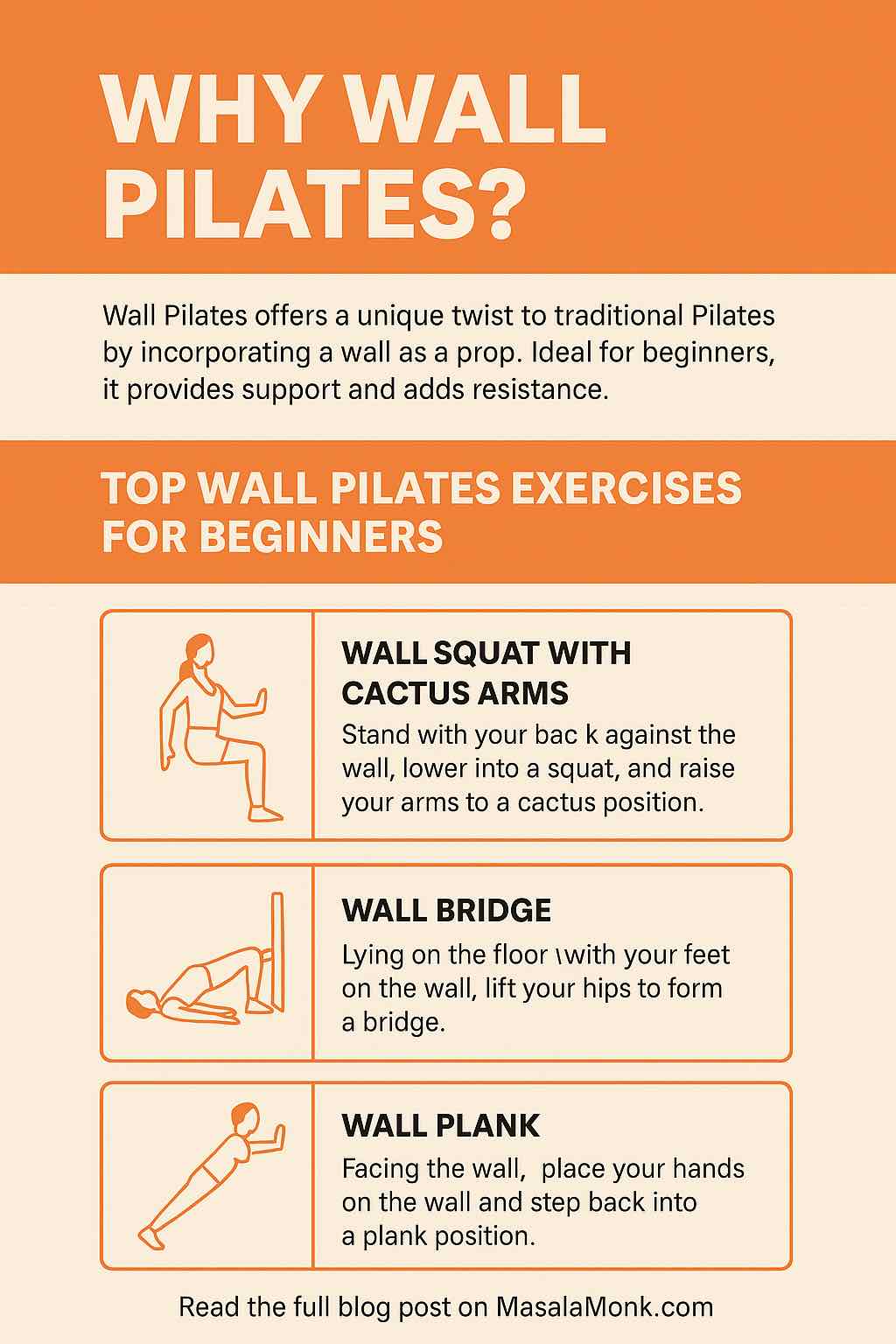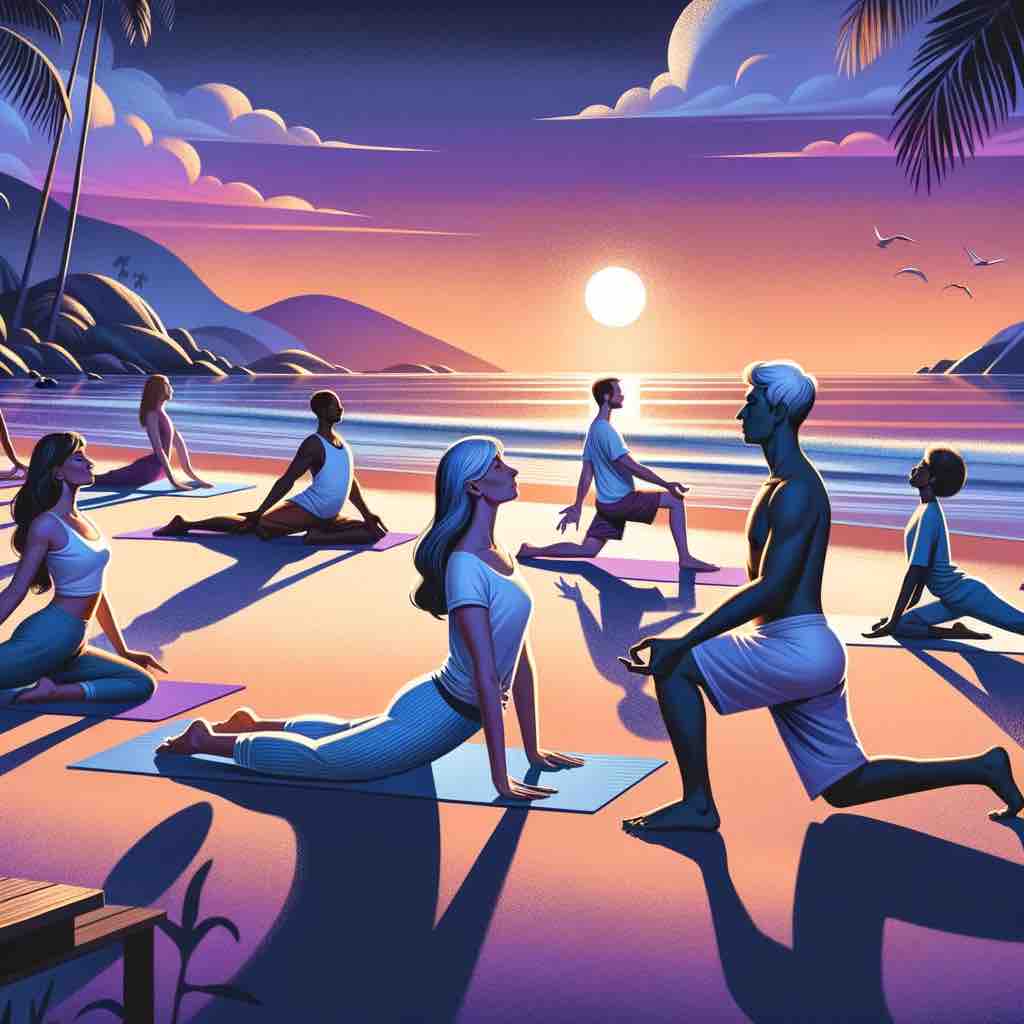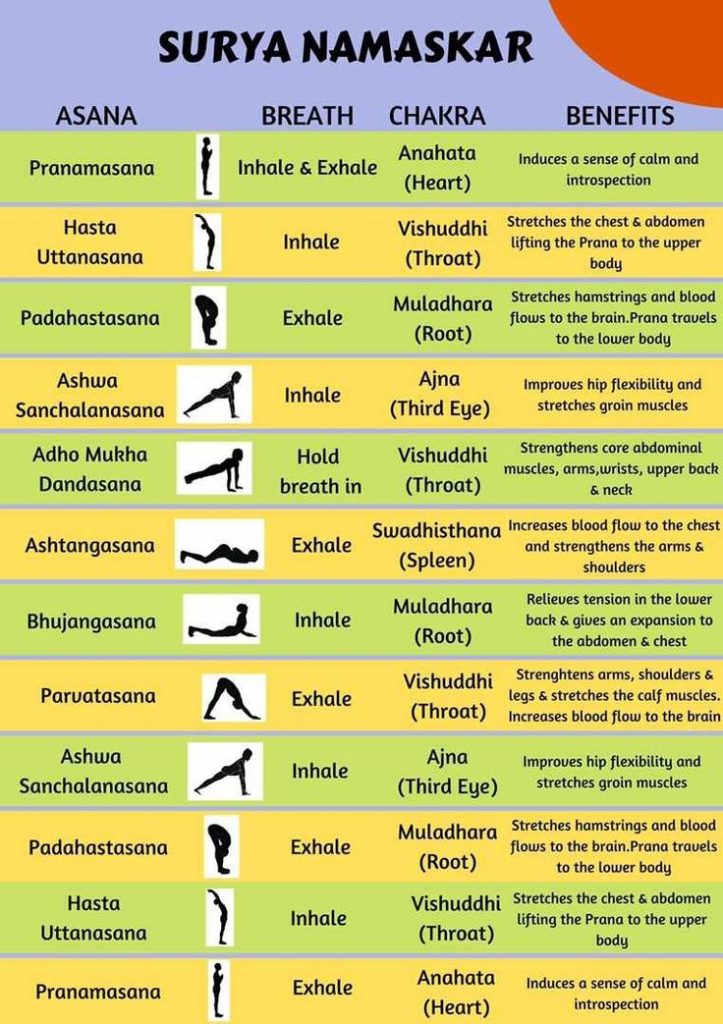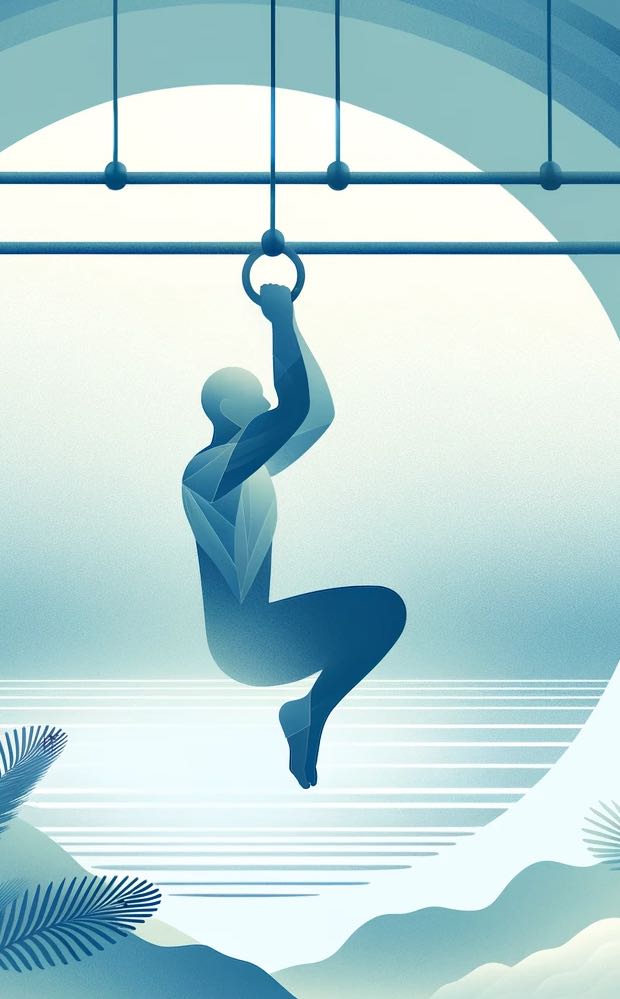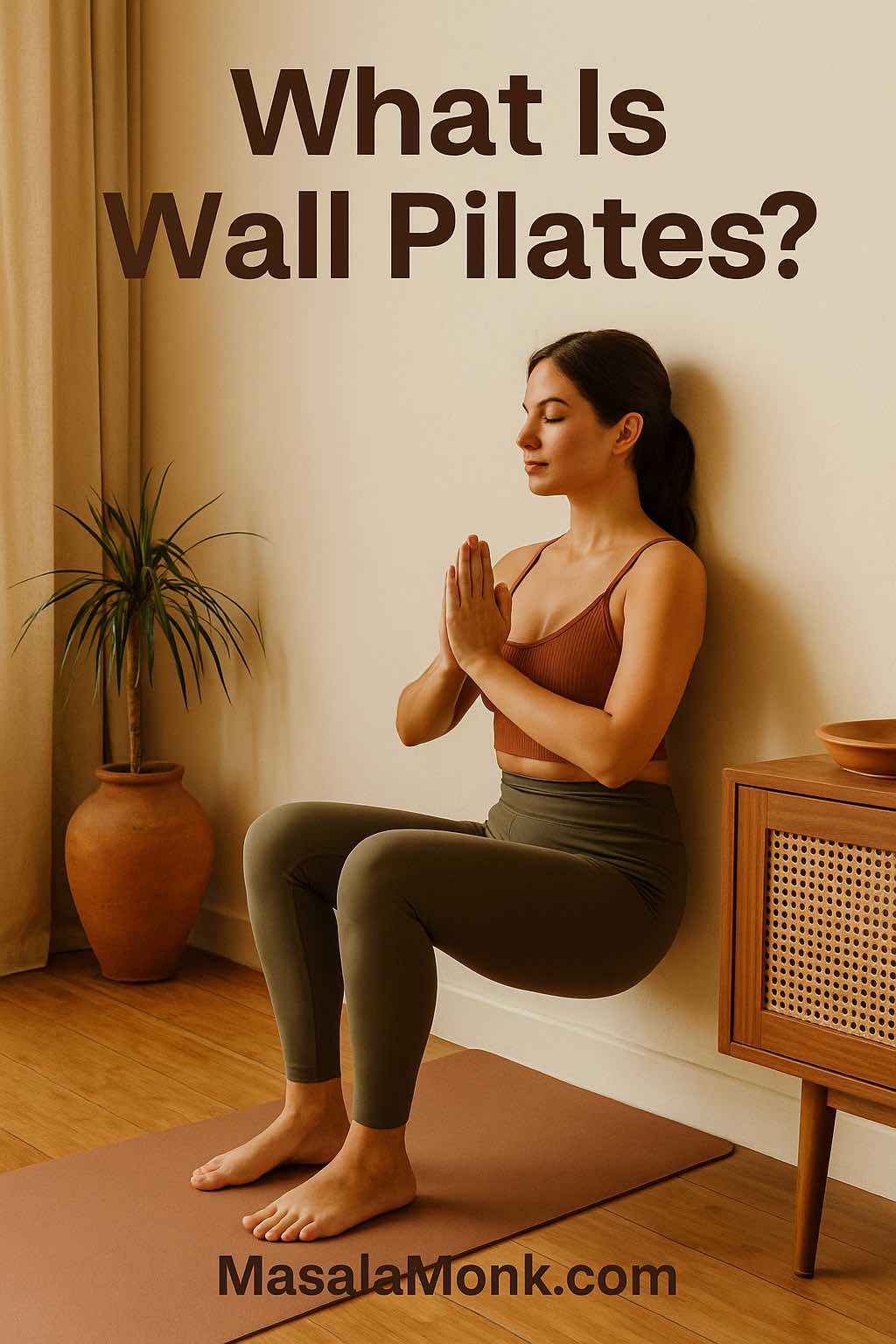
Have you ever looked at Pilates videos online and thought, “That looks amazing, but I don’t have a reformer or fancy studio”? Or maybe you tried Pilates on a mat but found yourself wobbling, unsure if your form was right, or just wishing you had a little more support. If so, you are not alone.
Most of us crave a way to feel stronger, more flexible, and upright in our bodies—without risking injury, spending hours in the gym, or buying expensive equipment. That’s where Wall Pilates comes in: a simple, genius method that turns your wall into the best fitness tool you never knew you had.
Whether you’re an absolute beginner, someone getting back into movement after a long break, or just curious about new ways to move, Wall Pilates offers a safe, gentle, and surprisingly powerful way to build a body you love—right at home.
Also Have a look at 28 Days AI-Powered Wall Pilates Challenge
Rediscovering Pilates—With a Wall
To understand Wall Pilates, it helps to know a bit about traditional Pilates first. Invented by Joseph Pilates in the early 20th century, Pilates is all about core strength, mindful movement, and building balanced muscles. The problem? Classic Pilates routines often require either a mat (which can be tough for true beginners) or expensive studio equipment.
Wall Pilates flips the script.
Instead of lying down on the floor and hoping you’re aligned, you use the wall as your guide. Pressing your back, feet, or hands into it, you get instant feedback on your posture—if your back isn’t flush against the wall, you’ll know! This makes learning the exercises safer, more intuitive, and way less intimidating.
Think of the wall as your built-in teacher, gently correcting you as you move.
Why Wall Pilates Is Suddenly Everywhere
You might have seen Wall Pilates popping up on social media or wellness blogs. The reason? It’s actually doable for regular people—no matter your fitness level, age, or body type.
- Beginner-friendly: The wall keeps you stable, so there’s no fear of falling or “doing it wrong.”
- Gentle on joints: Moves are low-impact, perfect for sensitive knees, hips, or lower backs.
- Full-body focus: Expect to feel this in your core, glutes, arms, and even your posture muscles—often from the very first session.
- Quick results: Many people notice improved posture and a stronger core within just a few weeks.
- No gear, no excuses: All you need is a clear patch of wall, a mat if you like, and your own body.
If you love the idea of steady progress and variety, check out the 28-Day Wall Pilates Challenge on MasalaMonk. It offers a structured, progressive plan for anyone who wants to build consistency, even if you only have a few minutes a day.
Who Should Try Wall Pilates? (Hint: Almost Everyone)
One of the best things about Wall Pilates is how inclusive it is. You don’t need a dance background, you don’t need to “be flexible first,” and you definitely don’t need expensive activewear.
Wall Pilates is perfect for:
- Beginners who want support and clear cues
- Seniors and anyone who wants a gentle approach to movement
- People returning from injury (with their doctor’s approval)
- Busy parents, professionals, and students who only have a small window for exercise
- Anyone in a small apartment or shared space
- Those looking to boost posture, reduce back pain, or gently build strength
The wall not only supports you, but also “coaches” you to move in a safer, smarter way. That means fewer aches, less guesswork, and more wins for your body.
If you’re brand new to Pilates, check out our Wall Pilates for Beginners: The Ultimate Guide for safety tips, basics, and the best way to start.
How Wall Pilates Works: The Magic of Feedback & Alignment
When you do Pilates on the floor, it can be easy to arch your back, tip your hips, or let your shoulders sneak up toward your ears. With Wall Pilates, the wall acts as a physical boundary. If your back leaves the wall during a squat, you’ll feel it immediately—and you’ll naturally correct your form.
This feedback helps you:
- Activate the right muscles (especially your core and glutes)
- Stay in a neutral spine position, protecting your back
- Get more out of each rep, since you can’t “cheat” the movement
- Build body awareness that carries over into daily life (like how you sit at your desk or carry groceries)
This focus on alignment makes Wall Pilates a favorite of physiotherapists, yoga teachers, and even personal trainers who want their clients to move better—not just more.
The Transformational Benefits of Wall Pilates
People fall in love with Wall Pilates because the benefits show up fast—and last.
1. Better Posture, Every Day
Many of us spend hours hunched over screens, developing tight hips and rounded shoulders. Wall Pilates exercises stretch the chest, open the hips, and teach your body what upright, healthy posture feels like.
You’ll finish each session taller, lighter, and with a sense of ease in your movement.
2. Core Strength That Really Works
Unlike crunches or planks, Wall Pilates teaches you to engage your core dynamically. The wall provides gentle resistance, asking your abs and back to stabilize you throughout each move.
3. Safe, Joint-Friendly Movement
No jumping, no jarring landings, and no pressure to “keep up” with an instructor. Every move can be modified—great for those with past injuries, arthritis, or simply wanting to move more gently.
4. Increased Body Awareness
Wall Pilates invites you to slow down, listen to your body, and notice which muscles are firing. That mindfulness makes every session a mini stress-relief ritual, not just another workout to check off your list.
5. Full-Body Toning (Not Just Abs!)
Expect to feel your glutes, thighs, shoulders, and even arms working with the right routine. And because you’re using your own body weight, the results are long, lean, and functional—not bulky.
Want to see just how effective a short session can be? Many MasalaMonk readers rave about the 15-Minute Belly Fat Burning Wall Pilates Workout—it’s a great next step if you want to target your core and burn some extra calories, all without leaving your living room.
The Mind-Body Connection: Wall Pilates Beyond Fitness
One of the greatest “secrets” of Pilates (wall or otherwise) is how it ties the body and mind together. Slow, intentional movements demand focus, helping you tune into your breath and shut out distractions.
Wall Pilates can be a moving meditation—a way to reset your mind while strengthening your body.
For even more support on your wellness journey, explore yoga routines like the Good Morning Yoga Routine on MasalaMonk, perfect for warming up, winding down, or finding calm on busy days. And if you’re curious how movement can ease stress and boost emotional resilience, Yoga for Mental Health: A Quick Guide offers simple, science-backed techniques anyone can try.
Getting Started: How to Begin Wall Pilates at Home
You don’t need much to get started:
- A clean wall (move any pictures, plants, or obstacles)
- A yoga mat or folded towel if you want a little cushion
- Comfortable clothes
- Willingness to listen to your body
Start with a gentle warm-up—walking around, shoulder rolls, or a few deep breaths.
If you need more guidance or want a complete primer before your first session, MasalaMonk’s Wall Pilates for Beginners: The Ultimate Guide breaks everything down step by step, with helpful tips for absolute beginners.
If you find that you’re sitting or standing for long hours (hello, work-from-home life!), complementing your Wall Pilates with postural yoga can make a huge difference. The Yoga for Posture: 7 Yoga Poses for Software Engineers is a great resource for keeping your spine and shoulders healthy in the digital age.
How to Get the Most Out of Wall Pilates
- Go slow. Rushing leads to poor form and less benefit. Savor each movement.
- Breathe with intention. Exhale as you press or lift, inhale as you return to start.
- Stay curious. Notice which muscles activate and which moves feel challenging.
- Modify when needed. Use the wall as much or as little as you need for balance.
- Celebrate your wins. Even five minutes counts—progress is progress!
And remember, you don’t have to do it all at once. Even a short, focused routine can bring big results if you stick with it.
If you’re ready to expand your practice, try supplementing with the 10-Minute Love Handles and Lower Belly Fat Workout—another quick, effective routine that pairs well with Wall Pilates.
Try This: 10-Minute Beginner Wall Pilates Routine
Take a few deep breaths. Let this be a break from your day—a time to reconnect with your body and move with intention. Go slowly, notice how you feel, and remember: it’s not about “nailing” every move, but about building awareness and feeling good.
1. Wall Roll Down
How to Do It:
- Stand with your back pressed against the wall, feet hip-width apart, about 12–18 inches from the base.
- Relax your arms by your sides, palms facing in.
- Take a breath in. As you exhale, gently drop your chin to your chest.
- Begin to roll your spine down, peeling one vertebra at a time off the wall. Imagine your back “melting” away from the wall, bit by bit, letting your head and arms hang heavy.
- Go as far as you comfortably can (maybe your fingertips reach your shins, maybe your toes).
- Pause. Breathe here, feeling a gentle stretch in your back and hamstrings.
- On your next inhale, press your feet into the floor and slowly stack your spine back up the wall, one vertebra at a time, until you’re standing tall again.
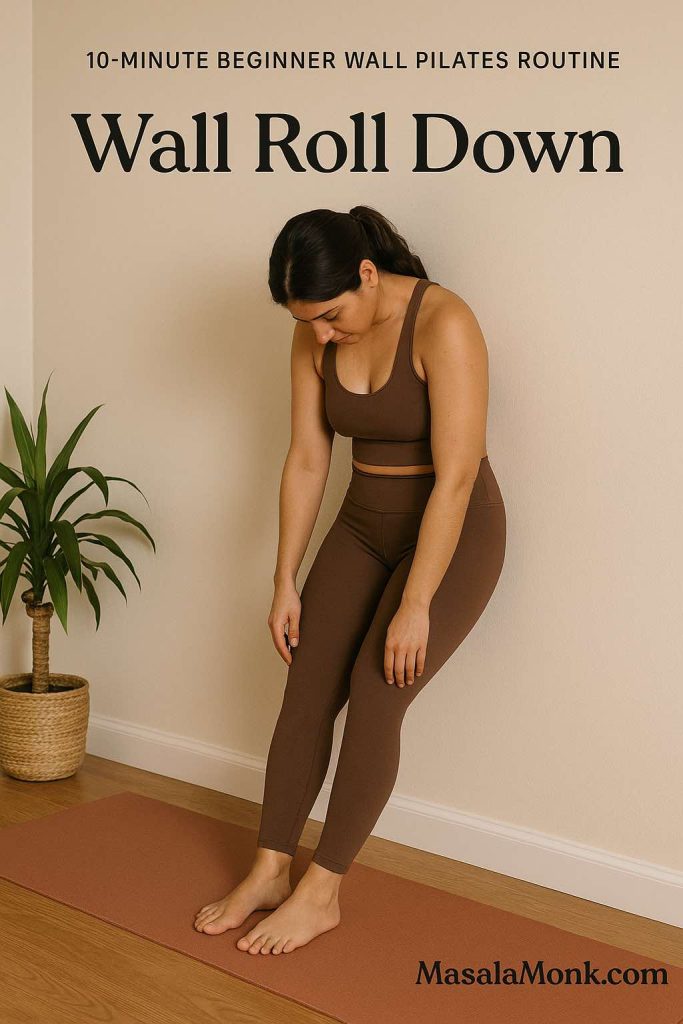
“Roll down the wall, one vertebra at a time, to stretch your spine and wake up your core.”
What to Notice:
- Feel your back “unfurling,” and your core engaging to help you rise.
- The wall provides a sense of reference for your spine’s alignment.
Common Mistakes:
- Rushing: Rolling too quickly, missing the articulation through each vertebra.
- Locked knees: Keep them soft to avoid straining your lower back.
- Pulling with the arms: Let gravity, not your hands, guide the descent.
Modifications:
- Bend your knees more if you have tight hamstrings.
- Only roll down as far as feels comfortable—don’t force it.
2. Wall Squat
How to Do It:
- With your back against the wall, walk your feet forward about two feet, hip-width apart.
- Slide your back down the wall until your thighs are parallel to the floor—like sitting in an invisible chair.
- Knees should be directly above your ankles, not past your toes.
- Press your lower back gently into the wall for support.
- Hold here, breathing slowly for 20–30 seconds, then slide back up to stand.

“Sit low in a wall squat—feel the burn in your legs and glutes as you build strength.”
What to Notice:
- The powerful work in your thighs and glutes as you hold.
- Your back supported and lengthened by the wall.
Common Mistakes:
- Knees caving in or drifting too far forward: Adjust your stance so knees are stacked over ankles.
- Arching your lower back: Press your entire back into the wall to protect your spine.
- Shoulders tensed up: Keep them relaxed and down.
Modifications:
- Lower your squat depth if the full position is too intense.
- Take breaks or hold for less time as needed.
3. Wall Bridge
How to Do It:
- Lie on your back with your hips near the wall and your feet pressed flat against it, knees bent about 90 degrees.
- Rest your arms by your sides, palms down.
- Press into your feet and lift your hips off the mat, forming a diagonal line from knees to shoulders.
- Squeeze your glutes at the top, then lower down with control.
- Repeat several times, moving with your breath.
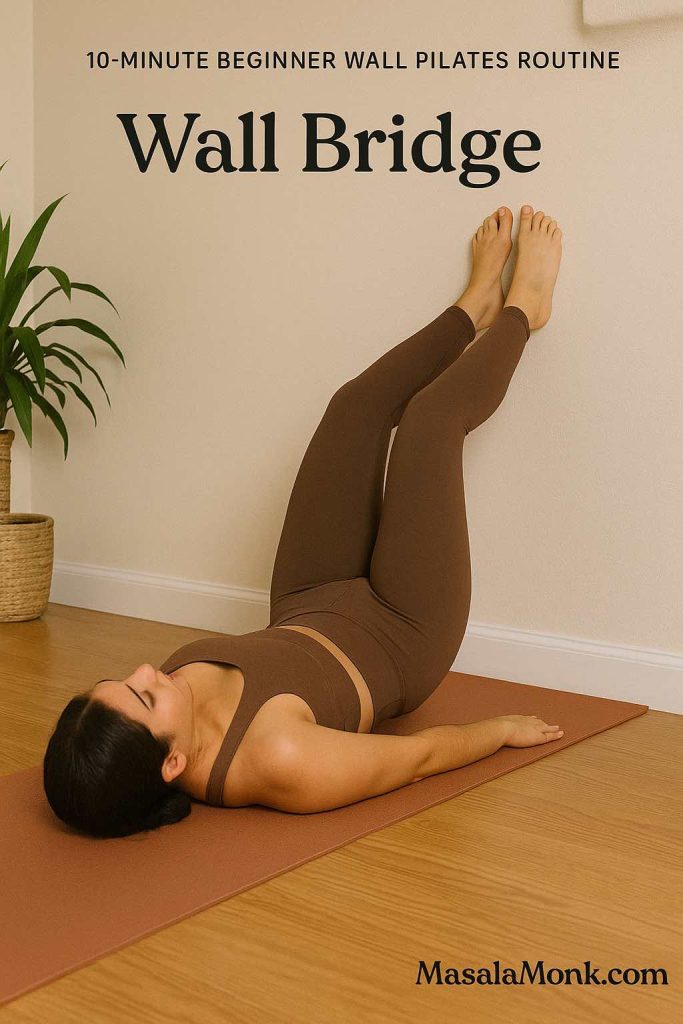
“Lift your hips into a bridge, pressing into the wall to activate your glutes and hamstrings.”
What to Notice:
- Activation in the glutes and hamstrings as you lift.
- Your shoulders and arms grounded for support.
Common Mistakes:
- Feet too high or low on the wall: Aim for a 90-degree angle at your knees.
- Overarching the back: Only lift as high as you can keep your ribs down and core engaged.
- Letting knees splay out or in: Keep them tracking straight over your feet.
Modifications:
- Don’t lift as high if you feel discomfort in your back.
- Support your lower back with a pillow or folded towel if needed.
4. Wall Push-Up
How to Do It:
- Stand facing the wall, feet hip-width and about arm’s length away.
- Place your palms flat on the wall at shoulder height, fingers spread wide.
- Inhale, bend your elbows, bringing your chest toward the wall—keep your body in a straight line from head to heels.
- Exhale, press through your palms to return to standing tall.
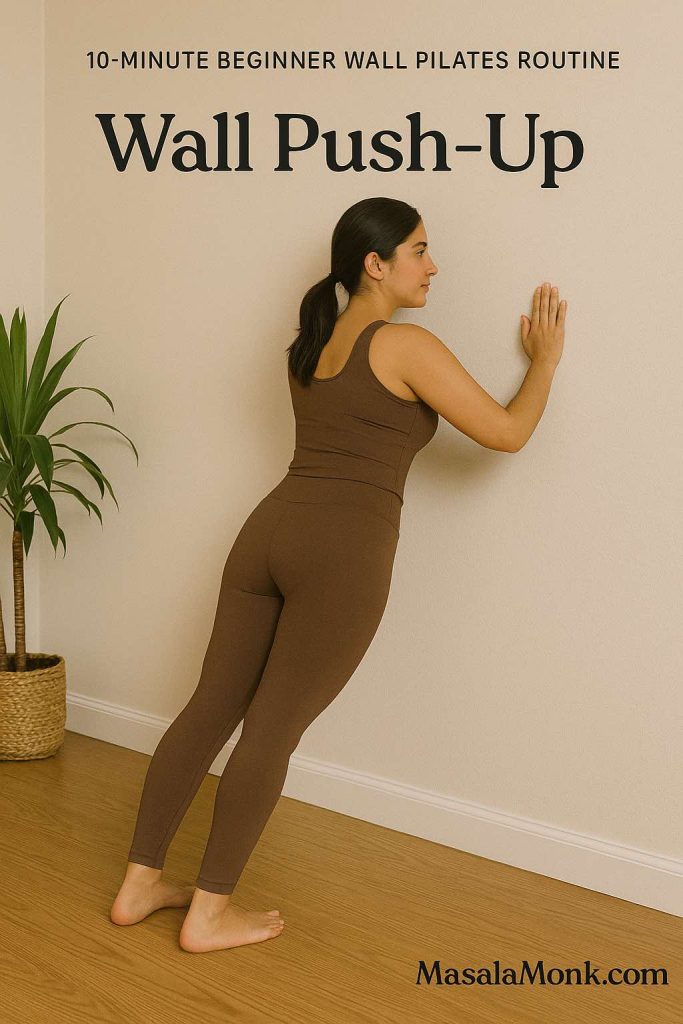
“Press away from the wall with strong arms and a stable core—perfect for building upper body strength.”
What to Notice:
- Core and chest muscles activating as you move.
- Smooth, controlled movement—not momentum.
Common Mistakes:
- Letting elbows flare out too wide: Keep them at about a 45-degree angle for shoulder safety.
- Sagging or arching your back: Engage your abs to keep your body aligned.
- Rushing the movement: Slow and steady builds strength.
Modifications:
- Step closer to the wall for less intensity, or further for more challenge.
- Try on your knees if standing is too difficult.
5. Wall Leg Slide
How to Do It:
- Stand sideways to the wall, one hand gently resting on it for support.
- Plant your standing leg firmly; keep your posture tall.
- Slowly slide your outside leg up and down along the wall, like a slow-motion side kick.
- Keep the movement controlled and your hips steady.
- Repeat, then switch sides.
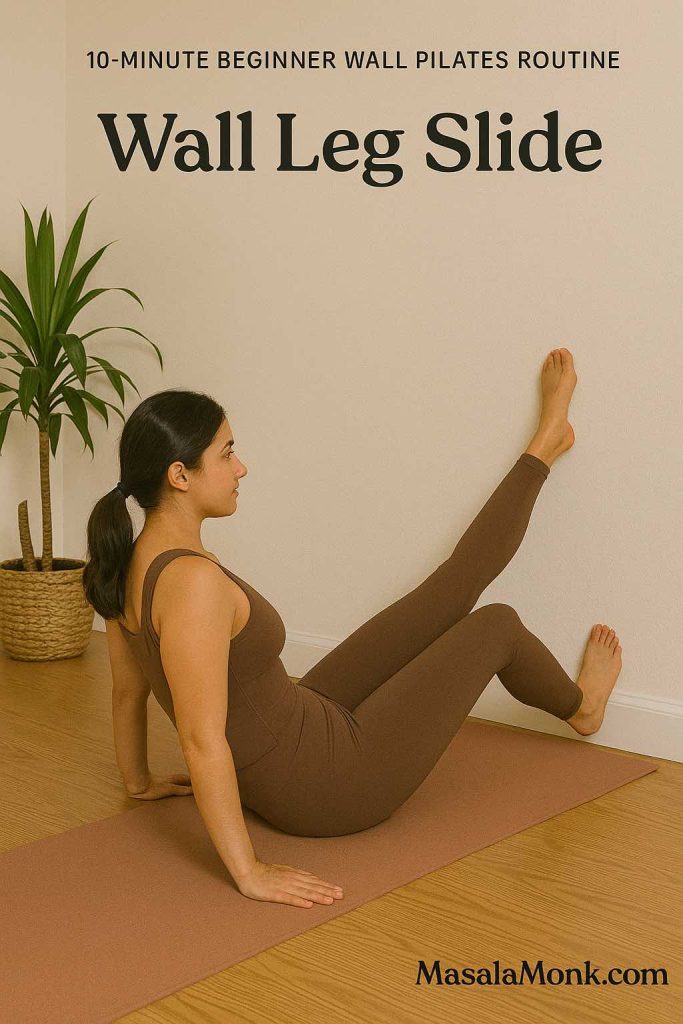
“Slide your leg up and down the wall, firing up your outer hips and improving balance.”
What to Notice:
- Engagement in the outer hip and thigh.
- Your core working to keep your torso stable.
Common Mistakes:
- Leaning into the wall: Use just a fingertip for balance, not to hold your weight.
- Swinging the leg too fast: Move slowly and with intention.
- Shrugging shoulders: Relax your neck and upper back.
Modifications:
- Slide your leg only as high as is comfortable.
- Hold onto a sturdy chair for additional balance.
6. Wall Angels
How to Do It:
- Stand with your back, head, and arms pressed flat against the wall, feet six inches away.
- Bend your elbows so your arms form a “W.”
- Slowly slide your arms up the wall, reaching overhead as far as you can without losing contact, then slide back down.
- Move within a pain-free range, keeping your core engaged.
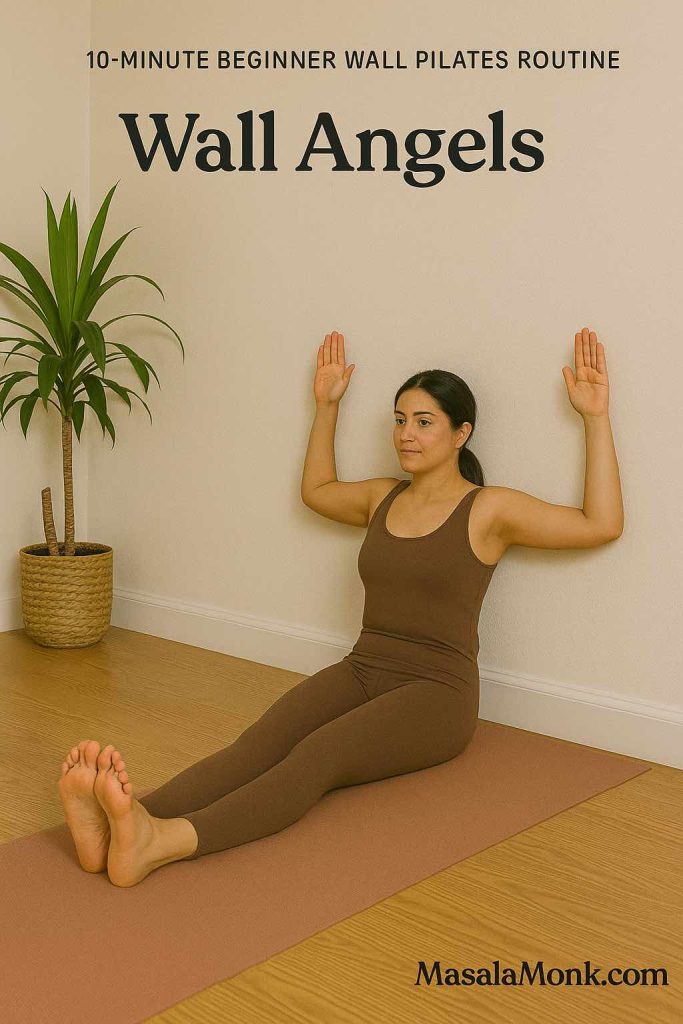
“Glide your arms overhead against the wall, opening your chest and strengthening your shoulders.”
What to Notice:
- A gentle stretch across your chest and a strengthening in your upper back.
- The wall helping to keep your shoulders aligned.
Common Mistakes:
- Arching your lower back: Keep ribs down, abs gently engaged.
- Losing contact with the wall: Go only as far as you can keep everything touching.
- Tensing the neck: Let your neck stay relaxed.
Modifications:
- Perform the move seated if standing is difficult.
- Decrease range of motion if you have shoulder tightness.
7. Standing Wall March
How to Do It:
- Lean your upper back and head gently against the wall, arms relaxed by your sides.
- Lift one knee up toward your chest, lower it, then lift the other.
- Alternate slowly, marching in place with control.
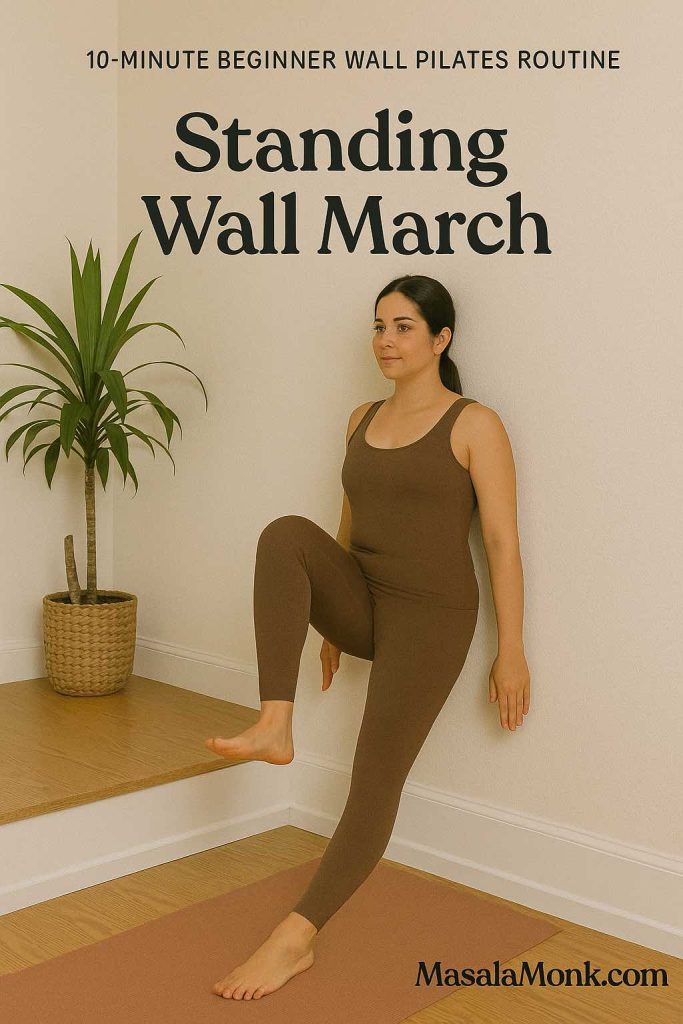
“March in place, leaning on the wall to challenge your balance and core.”
What to Notice:
- Your core muscles stabilizing your torso.
- The wall providing support so you can focus on alignment.
Common Mistakes:
- Letting your back arch away from the wall: Press it gently into the wall.
- Shrugging shoulders: Keep your upper body relaxed.
- Marching too quickly: Slow, controlled lifts are more effective.
Modifications:
- Lift knees only as high as is comfortable.
- Hold the wall lightly if you need extra balance.
8. Wall Plank
How to Do It:
- Start on your hands and knees with your feet near the base of the wall.
- Place your hands on the mat, shoulder-width apart.
- Carefully walk your feet up the wall, coming into a plank—body in a straight line, shoulders over wrists.
- Hold, breathing deeply, and engage your abs and glutes.

“Hold a plank with feet on the wall, engaging your whole body for stability and strength.”
What to Notice:
- Full-body activation, especially your core, shoulders, and legs.
- A sense of length from head to heels.
Common Mistakes:
- Letting hips sag or pike up: Keep your body in one straight line.
- Locking elbows: Keep a micro-bend to protect joints.
- Holding your breath: Keep breathing steadily.
Modifications:
- Only walk your feet a little up the wall for a gentler angle.
- Lower to your knees for less intensity.
9. Wall Calf Raise
How to Do It:
- Stand facing the wall, fingertips resting on it lightly for balance.
- Rise up onto the balls of your feet, lifting your heels as high as possible.
- Hold at the top for a breath, then slowly lower back down.
- Repeat for several reps.
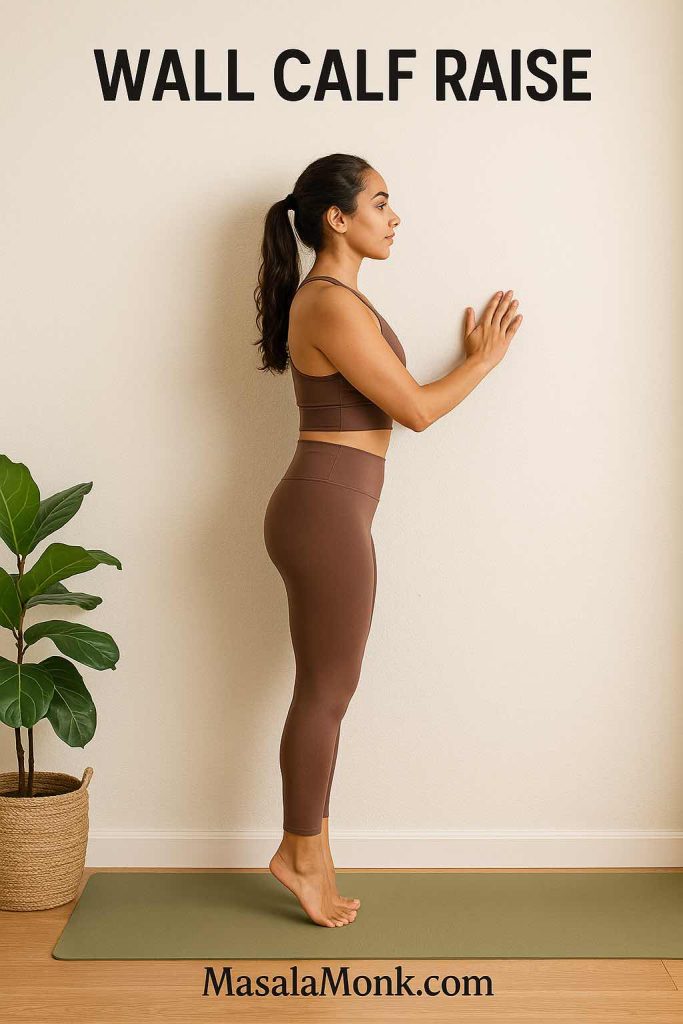
“Rise onto your toes with control, using the wall for balance and sculpting strong calves.”
What to Notice:
- Activation in your calf muscles and feet.
- Balance challenge—use the wall as much as needed.
Common Mistakes:
- Rocking forward: Lift straight up, not forward onto your toes.
- Bouncing: Control the movement, especially on the way down.
- Leaning too much into the wall: Use just enough support to stay upright.
Modifications:
- Hold each raise at the top for longer to increase intensity.
- Do one foot at a time for an extra challenge.
10. Cool Down Stretch
How to Do It:
- Stand with your back to the wall, feet hip-width apart.
- Cross your right ankle over your left knee, forming a figure-four.
- Slowly sit your hips back, as if sitting in a chair, feeling a stretch in your outer hip.
- Hold for 20–30 seconds, breathing deeply, then switch sides.
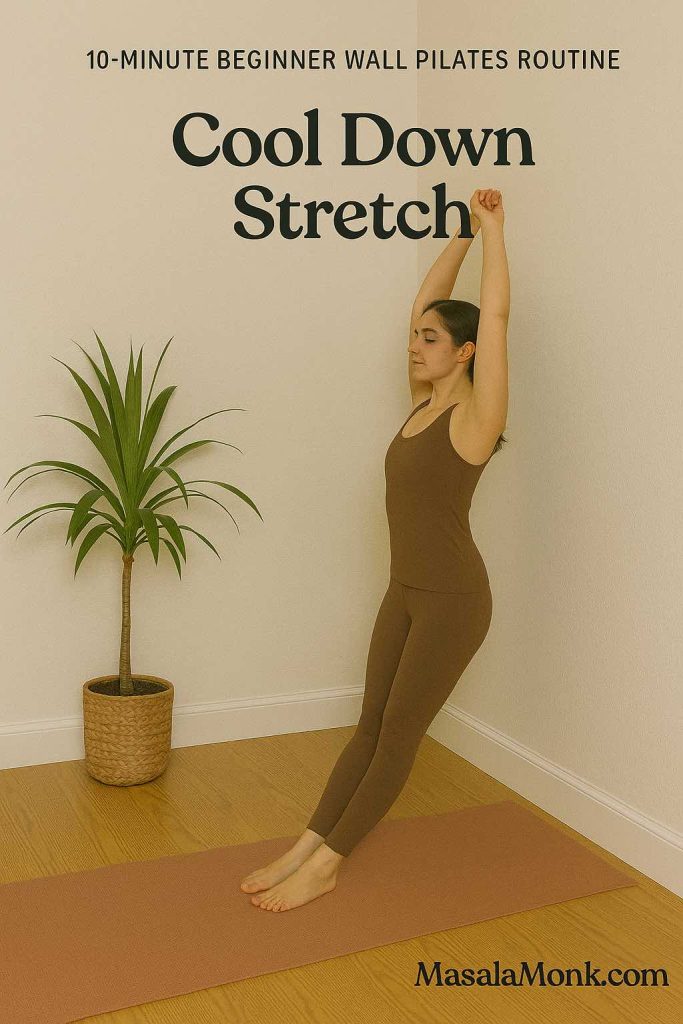
“Cross one ankle over your knee and sit back to stretch and release your hips.”
What to Notice:
- A gentle, opening stretch through the hip and glute.
- The support of the wall allowing you to relax deeper.
Common Mistakes:
- Collapsing the chest forward: Stay upright, using the wall to support your back.
- Holding your breath: Inhale and exhale slowly to deepen the stretch.
- Forcing the knee down: Let gravity and breath do the work; don’t push.
Modifications:
- Keep the stretch higher (don’t squat as deep) for less intensity.
- Use a chair for extra support if balancing is tough.
Breathe in, breathe out. Smile. You did it!
Take a moment to notice how your body feels—lighter, taller, maybe even a little bit more “awake” all over. Remember, it’s not about perfection; it’s about progress and feeling good in your skin.
Every time you show up for yourself like this, you’re not just working out—you’re building confidence, resilience, and a deeper connection to your body.
If you enjoyed this flow, you can repeat it daily or mix and match your favorite moves. For more ideas and next-level routines, explore the other Pilates and yoga guides on MasalaMonk—your body (and your mind) will thank you.
Routines To Try Next
- Want a little more intensity? Try this 15-Minute Belly Fat Burning Wall Pilates Workout for focused core and full-body toning.
- Looking to slim the waist and hit those side abs? This quick 10-Minute Love Handles and Lower Belly Fat Workout makes a perfect supplement.
Looking for Your Next Step?
Building a wellness routine is about more than just exercise—it’s about how you treat yourself all day long. Here are a few ways to keep the positive momentum going:
- Start your day with gentle movement and deep breathing. The Good Morning Yoga Routine is a wonderful way to wake up your body before breakfast or after a long night’s sleep.
- Need a break from your screen? Sneak in a few posture-fixing moves from the Yoga for Posture article. Your spine will thank you.
- Feeling stressed or overwhelmed? Movement is medicine. The Yoga for Mental Health resource on MasalaMonk can guide you through easy practices for mind and mood.
- Ready to make movement a daily habit? Join the supportive MasalaMonk community and explore challenges, new routines, and more.
Warm-Up, Recovery & Wellness
- Warm up or cool down with gentle movement using our Good Morning Yoga Routine.
- Fix your desk posture with Yoga for Posture: 7 Yoga Poses for Software Engineers—perfect for anyone working from home.
- Take care of your mind and body: read our Yoga for Mental Health: A Quick Guide.
Final Thoughts: Why Wall Pilates Might Be Exactly What You Need
Wall Pilates is more than just a trending workout—it’s a gentle, empowering approach to feeling stronger, taller, and more at ease in your body.
You don’t need the perfect setup, a special background, or even a lot of time.
All you need is a wall, your breath, and a willingness to begin.
Whether you’re a busy parent, a senior seeking safe movement, or anyone in between, Wall Pilates welcomes you. Every time you show up for yourself—even for a few minutes—you’re making an investment in your health, happiness, and confidence.
So next time you walk past that blank wall at home, see it for what it really is: your new workout buddy, teacher, and source of strength.
Let us know in the comments if you try Wall Pilates—what changed for you? What surprised you? And if you need ideas, support, or just a nudge to get started, we’re always here.
Visuals, stories, and support by MasalaMonk.com. Save or share this post if you found it useful, and keep an eye out for our upcoming 10-minute Wall Pilates routine!
FAQs: Wall Pilates
1. What is Wall Pilates and how is it different from regular Pilates?
Wall Pilates adapts traditional Pilates exercises by using a wall for support and resistance, which helps with alignment, balance, and core engagement—making it more accessible for beginners and those who want extra feedback on their form.
2. Do I need any special equipment for Wall Pilates?
No equipment is required—just a clear wall, a yoga mat (if you like extra comfort), and comfortable clothing.
3. Is Wall Pilates suitable for beginners?
Yes, Wall Pilates is perfect for beginners! The wall acts as your guide, providing support and helping you learn the correct technique with less risk of strain or injury.
4. Can I do Wall Pilates if I have joint pain or am recovering from injury?
Always check with your doctor first, but Wall Pilates is low-impact and can often be adapted for people with joint issues or those in rehabilitation, thanks to the wall’s support and the gentle, controlled movements.
5. How often should I practice Wall Pilates to see results?
Aim for 2–4 sessions per week to build strength and flexibility, though even once a week is beneficial. Consistency matters more than duration!
6. What are the main benefits of Wall Pilates?
Benefits include improved posture, stronger core and glutes, better balance, joint-friendly movement, and greater body awareness.
7. Can I lose weight or tone my body with Wall Pilates?
Wall Pilates can help tone and sculpt your body, improve muscle definition, and support healthy weight loss when combined with good nutrition and regular activity.
8. Is Wall Pilates good for seniors or people with limited mobility?
Yes, it’s very adaptable for seniors or anyone needing extra support. Moves can be modified for different abilities, and the wall makes balance and stability easier to manage.
9. How long does a typical Wall Pilates session last?
A routine can be as short as 10 minutes or up to 30 minutes, depending on your time and fitness level. Even short, focused sessions are effective.
10. Can I combine Wall Pilates with other forms of exercise?
Absolutely! Wall Pilates pairs well with walking, yoga, strength training, or even other Pilates routines, enhancing your overall fitness and flexibility.

